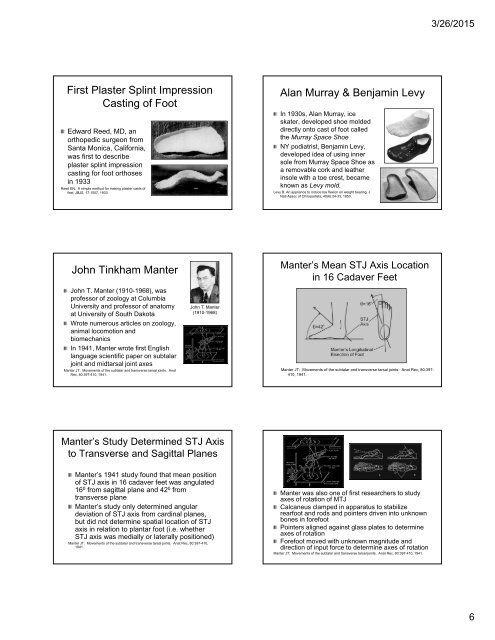History-Evolution-of-Foot-and-Lower-Extremity-Biomechanics-and-Foot-Orthoses_Kevin-Kirby
History-Evolution-of-Foot-and-Lower-Extremity-Biomechanics-and-Foot-Orthoses_Kevin-Kirby
History-Evolution-of-Foot-and-Lower-Extremity-Biomechanics-and-Foot-Orthoses_Kevin-Kirby
You also want an ePaper? Increase the reach of your titles
YUMPU automatically turns print PDFs into web optimized ePapers that Google loves.
3/26/2015<br />
First Plaster Splint Impression<br />
Casting <strong>of</strong> <strong>Foot</strong><br />
Edward Reed, MD, an<br />
orthopedic surgeon from<br />
Santa Monica, California,<br />
was first to describe<br />
plaster splint impression<br />
casting for foot orthoses<br />
in 1933<br />
Reed EN: A simple method for making plaster casts <strong>of</strong><br />
feet. JBJS, 17:1007, 1933.<br />
Alan Murray & Benjamin Levy<br />
In 1930s, Alan Murray, ice<br />
skater, developed shoe molded<br />
directly onto cast <strong>of</strong> foot called<br />
the Murray Space Shoe<br />
NY podiatrist, Benjamin Levy,<br />
developed idea <strong>of</strong> using inner<br />
sole from Murray Space Shoe as<br />
a removable cork <strong>and</strong> leather<br />
insole with a toe crest, became<br />
known as Levy mold.<br />
Levy B: An appliance to induce toe flexion on weight bearing. J<br />
Natl Assoc <strong>of</strong> Chiropodists, 40(6):24-33, 1950.<br />
John Tinkham Manter<br />
John T. Manter (1910-1968), was<br />
pr<strong>of</strong>essor <strong>of</strong> zoology at Columbia<br />
University <strong>and</strong> pr<strong>of</strong>essor <strong>of</strong> anatomy<br />
at University <strong>of</strong> South Dakota<br />
Wrote numerous articles on zoology,<br />
animal locomotion <strong>and</strong><br />
biomechanics<br />
In 1941, Manter wrote first English<br />
language scientific paper on subtalar<br />
joint <strong>and</strong> midtarsal joint axes<br />
Manter JT: Movements <strong>of</strong> the subtalar <strong>and</strong> transverse tarsal joints. Anat<br />
Rec, 80:397-410, 1941.<br />
John T. Manter<br />
(1910-1968)<br />
Manter’s Mean STJ Axis Location<br />
in 16 Cadaver Feet<br />
Manter JT: Movements <strong>of</strong> the subtalar <strong>and</strong> transverse tarsal joints. Anat Rec, 80:397-<br />
410, 1941.<br />
Manter’s Study Determined STJ Axis<br />
to Transverse <strong>and</strong> Sagittal Planes<br />
Manter’s 1941 study found that mean position<br />
<strong>of</strong> STJ axis in 16 cadaver feet was angulated<br />
16 0 from sagittal plane <strong>and</strong> 42 0 from<br />
transverse plane<br />
Manter’s study only determined angular<br />
deviation <strong>of</strong> STJ axis from cardinal planes,<br />
but did not determine spatial location <strong>of</strong> STJ<br />
axis in relation to plantar foot (i.e. whether<br />
STJ axis was medially or laterally positioned)<br />
Manter JT: Movements <strong>of</strong> the subtalar <strong>and</strong> transverse tarsal joints. Anat Rec, 80:397-410,<br />
1941.<br />
Manter was also one <strong>of</strong> first researchers to study<br />
axes <strong>of</strong> rotation <strong>of</strong> MTJ<br />
Calcaneus clamped in apparatus to stabilize<br />
rearfoot <strong>and</strong> rods <strong>and</strong> pointers driven into unknown<br />
bones in forefoot<br />
Pointers aligned against glass plates to determine<br />
axes <strong>of</strong> rotation<br />
Forefoot moved with unknown magnitude <strong>and</strong><br />
direction <strong>of</strong> input force to determine axes <strong>of</strong> rotation<br />
Manter JT: Movements <strong>of</strong> the subtalar <strong>and</strong> transverse tarsal joints. Anat Rec, 80:397-410, 1941.<br />
6


